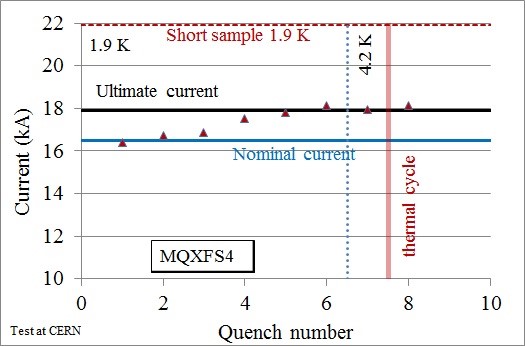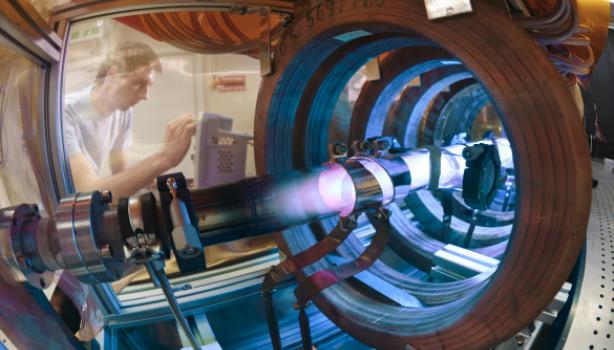In July, the fourth short model of the Nb3Sn quadrupole for the HL-LHC interaction regions was tested in SM18. This is the first magnet with the final Bruker-OST Restacked Rod Process (RRP®) conductor, with 108/127 layout, which shall be used for eight out of ten magnets of this series. As the third model tested one year ago, this was fully manufactured and assembled in CERN’s laboratory 927.
The magnet reached nominal current (7 TeV operation) with one quench, and ultimate current (7.5 TeV operation) after five quenches. “It has been the fastest training of the short models tested so far, approaching the performance of HQ, the magnet developed in the 2000’s by LARP that is the father of MQXF” – says J. Carlos Perez, in charge of the 927 magnet laboratory. The most relevant parameter for operation is the training after thermal cycle, since it provides an indication of the magnet behavior after installation. For this model no quench was required to reach 7.5 TeV operation, proving a perfect memory of the training.

Magnetic measurements confirmed a low value of the first order harmonics, already observed in the US prototype and in the third short model. This dodecapole component is 0.05% of the main field, whereas it should be not larger than 0.01%. A fine-tuning, foreseen in the initial design shall be carried out to recenter this unwanted harmonic around zero. This will be done through a modification of shims around the coil by a mere 0.125 mm.
The coils of the fifth and last short model have been manufactured, and the magnet, named MQXSF6, will be assembled in autumn. These coils are made with the final Bruker-EAS Powder-In-Tube (PIT) conductor, which will be used for one prototype and for two series magnet. “The MQXFS6 magnet will complete the short model programme of the HL-LHC Nb3Sn quadrupoles” – says G. de Rijk, in charge of the MSC/MDT section leading the short models and the correctors of HL-LHC – “but we remain ready to continue further work on short models, should we need additional information to be fed in the full size magnets”. The construction of the first full size CERN prototype MQXFBP1 is ongoing, and the second US prototype MQXFAP2 is undergoing cool-down for a test to start in a few weeks in BNL.


